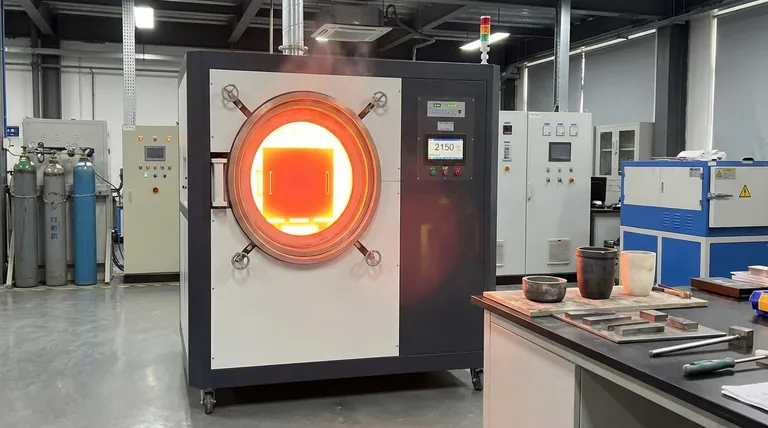In a vacuum furnace, "high temperature" is not a single number but a range that depends entirely on the furnace's design and its intended application. While standard operating temperatures often fall between 538°C (1000°F) and 1315°C (2400°F), specialized furnaces built for advanced materials can achieve temperatures well over 2000°C (3632°F). The specific temperature required is dictated by the precise thermal process being performed.
The critical takeaway is that a vacuum furnace's temperature capability is a direct function of its construction and heating technology. Understanding your specific material processing goal—whether it's standard heat treating or melting a high-performance alloy—is the key to determining the "high temperature" you actually need.

What Defines "High Temperature" in a Vacuum Furnace?
The term "high temperature" is relative. For some applications, 800°C is sufficient, while others require pushing the limits of modern materials science. The achievable temperature is determined by the furnace's core components.
The Standard Operating Range
For many common industrial processes like brazing, annealing, and hardening of standard metals, the typical "high temperature" range is between 538°C (1000°F) and 1315°C (2400°F). A furnace designed for this range offers a balance of performance, cost, and versatility.
The Upper Limits of Specialized Furnaces
When working with refractory metals, advanced ceramics, or novel alloys, much higher temperatures are necessary. This requires specialized equipment.
- A vacuum induction melting furnace is designed for melting and can reach a maximum temperature of 2000°C (3632°F).
- A vacuum graphite furnace, which uses graphite heating elements, can reach even higher, achieving a maximum of 2200°C (3992°F).
It's More Than Just Peak Temperature
A material's final properties are determined not just by the peak temperature it reaches, but by the entire thermal cycle. A typical high-temperature process involves controlled stages.
For example, a program might involve heating to 800°C for an initial hold, followed by a slow ramp to 1100°C for a prolonged hold or "soak." This precise control over heating rates and hold times is just as critical as the maximum temperature itself.
Why Are These High Temperatures Necessary?
Achieving these extreme temperatures in a vacuum is essential for creating high-performance materials and components that are impossible to produce in a standard atmosphere. The vacuum prevents oxidation and contamination at elevated temperatures.
Processing Advanced Materials
High-temperature vacuum furnaces are used to process a wide array of materials, including high-strength metal alloys, non-metallic materials like ceramics, and advanced composite materials.
Enabling Key Material Transformations
The controlled heat of a vacuum furnace is used to drive specific physical and chemical changes in materials. Key processes include:
- Melting & Crystallization: Creating pure, uniform ingots of metal or growing single crystals for semiconductors.
- Sintering: Fusing powdered materials (like ceramics or metal powders) into a solid, dense mass just below their melting point.
- Shaping & Forming: Heating materials to make them malleable for specialized shaping processes.
Understanding the Trade-offs
Selecting a furnace based on temperature alone is a mistake. The highest temperature is not always the best choice, as it comes with significant engineering and financial considerations.
Furnace Type vs. Maximum Temperature
The type of heating element and furnace construction directly dictates its capabilities. A graphite furnace can reach 2200°C, but for some alloys, the carbon atmosphere can be a source of contamination. An induction furnace is extremely fast but may not provide the uniform heating required for complex shapes.
Temperature vs. Process Control
As target temperatures increase, the demands on the system multiply. Higher temperatures require more advanced insulation, more sophisticated power and temperature controllers, and a more robust vacuum system, all of which increase cost and complexity.
Material Compatibility
The heating element material (e.g., graphite, molybdenum, tungsten) must be compatible with the material being processed. An inappropriate combination can lead to unwanted chemical reactions that ruin the product, especially at very high temperatures.
Making the Right Choice for Your Process
Your decision should be driven by the specific requirements of your material and desired outcome, not by a simple maximum temperature rating.
- If your primary focus is standard heat treating or brazing of steels: A furnace with a maximum temperature around 1300°C is typically sufficient and cost-effective.
- If your primary focus is melting refractory metals or sintering advanced ceramics: You will need a specialized graphite or induction furnace capable of reaching 2000°C or higher.
- If your primary focus is process precision for sensitive alloys: Prioritize a system with excellent temperature uniformity and advanced programming for controlling ramp rates and soak times.
Ultimately, matching the furnace's capabilities to your specific process requirements ensures both technical success and economic efficiency.
Summary Table:
| Temperature Range | Typical Applications | Furnace Type |
|---|---|---|
| 538°C - 1315°C | Brazing, Annealing, Hardening | Standard Vacuum Furnace |
| Up to 2000°C | Melting Refractory Metals | Vacuum Induction Melting Furnace |
| Up to 2200°C | Sintering Advanced Ceramics | Vacuum Graphite Furnace |
Need precise high-temperature control for your lab's material processing? KINTEK specializes in lab equipment and consumables, providing vacuum furnaces tailored to your specific thermal process requirements—from standard heat treating to advanced material synthesis. Contact us today to discuss how our solutions can enhance your lab's efficiency and material outcomes!
Visual Guide

Related Products
- Vacuum Heat Treat Furnace with Ceramic Fiber Liner
- Molybdenum Vacuum Heat Treat Furnace
- Vacuum Heat Treat Sintering Brazing Furnace
- Vacuum Heat Treat and Molybdenum Wire Sintering Furnace for Vacuum Sintering
- Vacuum Hot Press Furnace Heated Vacuum Press Machine Tube Furnace
People Also Ask
- What is a vacuum furnace used for? Unlock Purity in High-Temperature Processing
- Why do you vacuum for heat treatment? Achieve Flawless, High-Performance Metal Components
- Can I vacuum the inside of my furnace? A Guide to Safe DIY Cleaning vs. Professional Service
- How to vacuum out a furnace? A Step-by-Step Guide to Safe DIY Maintenance
- What are the advantages of a vacuum furnace? Achieve Superior Purity and Control in Heat Treatment



















